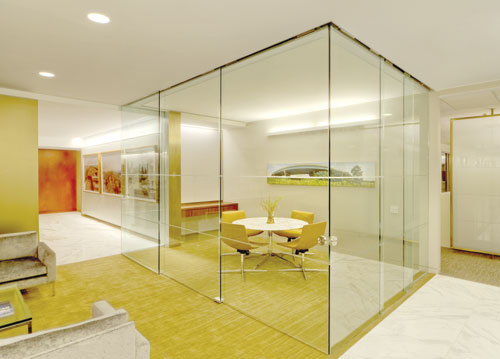Interior Sliding Frameless Glass Doors Make a Clear Contribution to LEED
Glass Walls
Sliding doors with glass sidelights add more glass to the project while helping to divide interiors with elegance and transparency. Some systems allow minimum hardware presence as tracks can be recessed and no jamb is required between the panels. Although the design features frameless glass doors, the gap between sliders and fixed panels is typically 3/8 inch for a better integration of the system.
Sliding doors with a glass transom-mounted track is a popular choice in creating a modern design aesthetic while fitting a sliding door in an opening over 10 feet.
Telescopic Glass Doors
Telescopic glass doors are no longer a succession of tracks mounted next to each other by an inventive glass contractor but a sophisticated, ingenious, and well-developed system allowing the doors to slide simultaneously while operating only the lead door. Telescopic doors operate with two, three, or four frameless glass panels without any floor tracks, leaving a clear opening up to 16 feet. Many designers have already adopted this option in high-end settings for conference room entrances or hotel lobbies that provide an elegant reception area for their guests.
Corner Glass Doors
An elegant private space can be easily created within an open concept environment. Non-conventional door enclosures and floor-to-ceiling glass panels make for a new and dramatic way of entering work or living areas. This new generation of corner doors enables designers to create a glass cube with the unique feature of allowing the doors to open at 90 degrees simultaneously. When one door is activated, the other slides open simultaneously along an existing wall or glass sidelight. This high-concept application is ideal for conference rooms, management offices, or corner bathroom entrances in a striking opening that frees up other passageways. This installation increases overall transfer of natural light and air circulation over conventional walls.
All the above-mentioned systems feature glass panels that can be installed free of floor tracks, achieving both minimalist design and a more convenient application for projects with Americans with Disabilities Act (ADA) requirements. Heavy glass panels are held by high-weight capacity pressure clamps, which avoid the need to drill holes in the glass. For best accessibility, sliding doors will have advanced ball-bearing technology that allows 400 pounds of doors to slide with less than 5 pounds of force, also an ADA stipulation.
Glass Options
For many years, tempered glass panels have been selected exclusively for commercial interiors at the expense of laminated glass, which can actually offer significantly more design options at a reasonable price. Both glass types offer aftermarket recyclability.
Tempered glass. Tempered glass has high resistance to both impact and temperature changes. This is due to its fabrication process in which the glass, which has been previously cut and prepared with holes and edge finishes, is subjected to temperatures up to 1,540°F, and then suddenly cooled through air tubes. Although tempered glass is stronger than laminated against direct forces, its use in commercial interiors is sometimes being reconsidered, as it can fracture into many pieces as a result of slight contact to edges or corners. In a second safety process, known as the heat soak test, glass can be subjected to another controlled high-temperature oven to improve the glass quality.
 |
The new generation of corner doors gives designers the option to create a clear tempered glass cube with the unique application of allowing the doors to open at 90 degrees simultaneously. Photo courtesy of Klein USA, Inc. |









